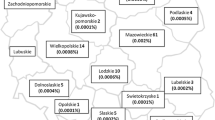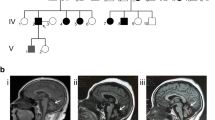Abstract
Spinocerebellar ataxia type 10 (SCA10) is an autosomal dominant neurodegenerative disorder characterized by progressive cerebellar ataxia and epilepsy. The disease is caused by a pentanucleotide ATTCT expansion in intron 9 of the ATXN10 gene on chromosome 22q13.3. SCA10 has shown a geographical distribution throughout America with a likely degree of Amerindian ancestry from different countries so far. Currently available data suggest that SCA10 mutation might have spread out early during the peopling of the Americas. However, the ancestral origin of SCA10 mutation remains under speculation. Samples of SCA10 patients from two Latin American countries were analysed, being 16 families from Brazil (29 patients) and 21 families from Peru (27 patients) as well as 49 healthy individuals from Indigenous Quechua population and 51 healthy Brazilian individuals. Four polymorphic markers spanning a region of 5.2 cM harbouring the ATTCT expansion were used to define the haplotypes, which were genotyped by different approaches. Our data have shown that 19-CGGC-14 shared haplotype was found in 47% of Brazilian and in 63% of Peruvian families. Frequencies from both groups are not statistically different from Quechua controls (57%), but they are statistically different from Brazilian controls (12%) (p < 0.001). The most frequent expanded haplotype in Quechuas, 19-15-CGGC-14-10, is found in 50% of Brazilian and in 65% of Peruvian patients with SCA10. These findings bring valuable evidence that ATTCT expansion may have arisen in a Native American chromosome.



Similar content being viewed by others
References
Almeida, T., Alonso, I., Martins, S., Ramos, E. M., Azevedo, L., Ohno, K., et al. (2009). Ancestral origin of the ATTCT repeat expansion in spinocerebellar ataxia type 10 (SCA10). PLoS ONE, 4(2), e4553.
Alonso, I., Jardim, L. B., Artigalas, O., Saraiva-Pereira, M. L., Matsuura, T., Ashizawa, T., et al. (2006). Reduced penetrance of intermediate size alleles in spinocerebellar ataxia type 10. Neurology, 66(10), 1602–1604.
Ashizawa, T. (2012). Spinocerebellar ataxia type 10. Handbook of Clinical Neurology, 103, 507–519.
Avena, S., Via, M., Ziv, E., Pérez-Stable, E. J., Gignoux, C. R., Dejean, C., et al. (2012). Heterogeneity in genetic admixture across different regions of Argentina. PLoS ONE, 7(4), e34695.
Bortolini, M. C., González-José, R., Bonatto, S. L., & Santos, F. R. (2014). Reconciling pre-Columbian settlement hypotheses requires integrative, multi-disciplinary, and model-bound approaches. Proceedings of the National Academy of Science of USA, 111(2), 213–214.
Bortolini, M. C., Salzano, F. M., Thomas, M. G., Stuart, S., Nasanen, S. P., Bau, C. H., et al. (2003). Y-chromosome evidence for differing ancient demographic histories in the Americas. American Journal of Human Genetics, 73(3), 524–539.
Brusco, A., Gellera, C., Cagnoli, C., Saluto, A., Castucci, A., Michielotto, C., et al. (2004). Molecular genetics of hereditary spinocerebellar ataxia: Mutation analysis of spinocerebellar ataxia genes and CAG/CTG repeat expansion detection in 225 Italian families. Archives of Neurology, 61(5), 727–733.
Bushara, K., Bower, M., Liu, J., McFarland, K. N., Landrian, I., Hutter, D., et al. (2013). Expansion of the spinocerebellar ataxia type 10 (SCA10) repeat in a patient with Sioux Native American Ancestry. PLoS ONE, 8(11), e81342.
Fagundes, N. J., Kanitz, R., Eckert, R., Valls, A. C., Bogo, M. R., Salzano, F. M., et al. (2008). Mitochondrial population genomics supports a single pre-Clovis origin with a coastal route for the peopling of the Americas. American Journal of Human Genetics, 82(3), 583–592.
Fujigasaki, H., Tardieu, S., Camuzat, A., Stevanin, G., LeGuern, E., Matsuura, T., et al. (2002). Spinocerebellar ataxia type 10 in the French population. Annals of Neurology, 51(3), 408–409.
Gallardo, M., & Soto, A. (2009). Clinical characterization of a Venezuelan family with spinocerebellar ataxia type 10. Movement Disorder, 24, S12.
Gatto, E. M., Gao, R., White, M. C., Uribe Roca, M. C., Etcheverry, J. L., Persi, G., et al. (2007). Ethnic origin and extrapyramidal signs in an Argentinian spinocerebellar ataxia type 10 family. Neurology, 69(2), 216–218.
Gheno, T. C., Furtado, G. V., Saute, J. A. M., Donis, K. C., Fontanari, A. M. V., Emmel, V. E., et al. (2017). Spinocerebelar ataxia type 10: Common haplotype and disease progression rate in Peru and Brazil. European Journal of Neurology, 24(7), 892–e36.
González-José, R., Bortolini, M. C., Santos, F. R., & Bonatto, S. L. (2008). The peopling of America: Craniofacial shape variation on a continental scale and its interpretation from an interdisciplinary view. American Journal of Physical Anthropology, 137(2), 175–187.
Grewal, R. P., Achari, M., Matsuura, T., Durazo, A., Tayag, E., Zu, L., et al. (2002). Clinical features and ATTCT repeat expansion in spinocerebellar ataxia type 10. Archives of Neurology, 59(8), 1285–1290.
Grewal, R. P., Tayag, E., Figueroa, K. P., Zu, L., Durazo, A., Nunez, C., et al. (1998). Clinical and genetic analysis of a distinct autosomal dominant spinocerebellar ataxia. Neurology, 51(5), 1423–1426.
Kapur, S. S., & Goldman, J. G. (2012). Two in one: Report of a patient with spinocerebellar ataxia type 2 and 10. Archives of Neurology, 69(9), 1200–1203.
Leonardi, L., Marcotulli, C., McFarland, K. N., Tessa, A., DiFabio, R., Santorelli, F. M., et al. (2014). Spinocerebellar ataxia type 10 in Peru: The missing link in the Amerindian origin of the disease. Journal of Neurology, 261(9), 8–11.
Lins, T. C., Vieira, R. G., Abreu, B. S., Grattapaglia, D., & Pereira, R. W. (2010). Genetic composition of Brazilian population samples based on a set of twenty-eight ancestry informative SNPs. American Journal of Human Biology, 22(2), 187–192.
Matsuura, T., Achari, M., Khajavi, M., Bachinski, L. L., Zoghbi, H. Y., & Ashizawa, T. (1999). Mapping of the gene for a novel spinocerebellar ataxia with pure cerebellar signs and epilepsy. Annals of Neurology, 45(3), 407–411.
Matsuura, T., Ranum, L. P., Volpini, V., Pandolfo, M., Sasaki, H., Tashiro, K., et al. (2002). Spinocerebellar ataxia type 10 is rare in populations other than Mexicans. Neurology, 58(6), 983–984.
Matsuura, T., Yamagata, T., Burgess, D. L., Rasmussen, A., Grewal, R. P., Watase, K., et al. (2000). Large expansion of the ATTCT pentanucleotide repeat in spinocerebellar ataxia type 10. Nature Genetics, 26(2), 191–194.
Miller, A. S., Dykes, D. D., & Plesky, H. F. (1998). A sample salting-out procedure of extracting DNA from nucleated cells. Nucleic Acids Research, 16(3), 1215.
Naito, H., Takahashi, T., Kamada, M., Morino, H., Yoshino, H., Hattori, N., et al. (2017). First report of a Japanese family with spinocerebellar ataxia type 10: The second report from Asia after a report from China. PLoS ONE, 12(5), e0177955.
Network 4.5.1.6. http://www.fluxus-engineering.com/. Accessed June 2, 2015.
Price, A. L., Patterson, N., Yu, F., Cox, D. R., Waliszewska, A., McDonald, G. J., et al. (2007). A genome-wide admixture map in Latino populations. American Journal of Human Genetics, 80(6), 1024–1036.
Raskin, S., Ashizawa, T., Teive, H. A., Arruda, W. O., Fang, P., Gao, R., et al. (2007). Reduced penetrance in a Brazilian family with spinocerebellar ataxia type 10. Archives of Neurology, 64(4), 591–594.
Rasmussen, A., Matsuura, T., Ruano, L., Yescas, P., Ochoa, A., Ashizawa, T., et al. (2001). Clinical and genetic analysis of four Mexican families with spinocerebellar ataxia 10. Annals of Neurology, 50(2), 234–239.
Roxburgh, H. R., Smith, O. C., Lim, J. G., Bachman, D. F., Byrd, E., & Bird, T. D. (2013). The unique co-occurrence of spinocerebellar ataxia type 10 (SCA10) and Huntington disease. Journal of the Neurological Science, 324(1–2), 176–178.
Ruiz-Linares, A., Adhikari, K., Acuña-Alonzo, V., Quinto-Sanchez, M., Jaramillo, C., Arias, W., et al. (2014). Admixture in Latin America: Geographic structure, phenotypic diversity and self-perception of ancestry based on 7,342 individuals. PLoS Genetics, 10(9), e1004572.
Seldin, M. F., Tian, C., Shigeta, R., Scherbarth, H. R., Silva, G., Belmont, J. W., et al. (2007). Argentine population genetic structure: A large variance in Amerindian contribution. American Journal of Physical Anthropology, 132(3), 455–462.
Stephens, M., Smith, N. J., & Donnelly, P. (2001). A new statistical method for haplotype reconstruction from population data. American Journal of Human Genetics, 68(4), 978–989.
Sułek-Piatkowska, A., Zdzienicka, E., Raczyńska-Rakowicz, M., Krysa, W., Rajkiewicz, M., Szirkowiec, W., et al. (2010). The occurrence of spinocerebellar ataxias caused by dynamic mutations in Polish patients. Neurologia i Neurochirurgia Polska, 44(3), 238–245.
Tarazona-Santos, E., Carvalho-Silva, D. R., Pettener, D., Luiselli, D., De Stefano, G. F., Labarga, C. M., et al. (2001). Genetic differentiation in South Amerindians is related to environmental and cultural diversity: Evidence from the Y chromosome. American Journal of Human Genetics, 68(6), 1485–1496.
Teive, H. A., & Ashizawa, T. (2013). Spinocerebellar ataxia type 10: From Amerindians to Latin Americans. Current Neurology and Neuroscience Reports, 13(11), 393.
Teive, H. A., Munhoz, R. P., Arruda, W. O., Raskin, S., Werneck, L. C., & Ashizawa, T. (2011). Spinocerebellar ataxia type 10—A review. Parkinsonism Related Disorders, 17(9), 655–661.
Teive, H. A., Munhoz, R. P., Raskin, S., Arruda, W. O., de Paola, L., Werneck, L. C., et al. (2010). Spinocerebellar ataxia type 10: Frequency of epilepsy in a large sample of Brazilian patients. Movement Disorder, 25(16), 2875–2878.
Teive, H. A., Roa, B. B., Raskin, S., Fang, P., Arruda, W. O., Neto, Y. C., et al. (2004). Clinical phenotype of Brazilian families with spinocerebellar ataxia 10. Neurology, 63(8), 1509–1512.
Vale, J., Bugalho, P., Silveira, I., Sequeiros, J., Guimarães, J., & Coutinho, P. (2010). Autosomal dominant cerebellar ataxia: Frequency analysis and clinical characterization of 45 families from Portugal. European Journal of Neurology, 17(1), 124–128.
Wang, S., Lewis, C. M., Jakobsson, M., Ramachandran, S., Ray, N., Bedoya, G., et al. (2007). Genetic variation and population structure in Native Americans. PLoS Genetics, 3(11), e185.
Wang, K., McFarland, K. N., Liu, J., Zeng, D., Landrian, I., Xia, G., et al. (2015). Spinocerebellar ataxia type 10 in Chinese Han. Neurology Genetics, 1(3), e26.
Wang, J., Shen, L., Lei, L., Xu, Q., Zhou, J., Liu, Y., et al. (2011). Spinocerebellar ataxias in mainland China: An updated genetic analysis among a large cohort of familial and sporadic cases. Zhong Nan Da Xue Xue Bao Yi Xue Ban, 36(6), 482–489.
Acknowledgements
The authors are grateful to patients and their families as well as healthy individuals for providing biological material for this study. We would also like to thank Vanessa Paixão-Côrtes, Nelson Jurandi Rosa Fagundes, and Virginia Ramallo for their contribution in this study.
Funding
This research was supported by Brazilian Funding Agencies: Conselho Nacional de Desenvolvimento Científico e Tecnológico (CNPq) and Fundo de Incentivo a Pesquisa e Eventos do HCPA (FIPE-HCPA).
Author information
Authors and Affiliations
Consortia
Corresponding author
Ethics declarations
Conflict of interest
All authors declare themselves to have no conflict of interest in this research work.
Electronic supplementary material
Below is the link to the electronic supplementary material.
Rights and permissions
About this article
Cite this article
Bampi, G.B., Bisso-Machado, R., Hünemeier, T. et al. Haplotype Study in SCA10 Families Provides Further Evidence for a Common Ancestral Origin of the Mutation. Neuromol Med 19, 501–509 (2017). https://doi.org/10.1007/s12017-017-8464-8
Received:
Accepted:
Published:
Issue Date:
DOI: https://doi.org/10.1007/s12017-017-8464-8




